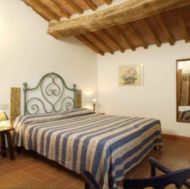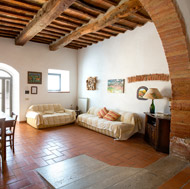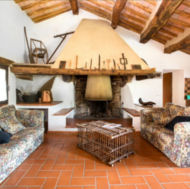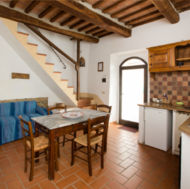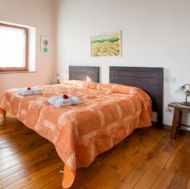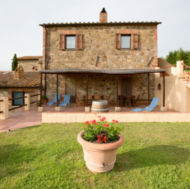Val d'Orcia
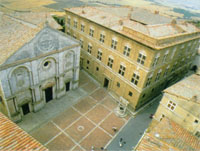 PIENZAThe town stands on the top of a hill which overlooks the splendid Val d'Orcia. Enea Silvio Piccolomini was born here in 1405 and when he became pope Pius II in 1458 he decided to transform his modest village into the perfect town, an admirable example of the humanistic period, and entrusted the design to Bernardo Rossellino. Piazza Pio II is intact, incorporanting the most rigorous of Renaissance perspective, and containing the cathedral and Palazzo Piccolomini. The town's main axis is corso Rossellino, lined with houses built by the nobility in the 14th century. Pienza is a mainly agricultural centre, particularly famous for its pecorino cheese. The traditional cheese show, "fiera del cacio" takes place on the first Sunday in September. The flower show "Pienza e i fiori" takes place in mid May. Also to be visited is Monticchiello, made famous by its "Teatro povero", a new play anacted each summer by the local inhabitants.
PIENZAThe town stands on the top of a hill which overlooks the splendid Val d'Orcia. Enea Silvio Piccolomini was born here in 1405 and when he became pope Pius II in 1458 he decided to transform his modest village into the perfect town, an admirable example of the humanistic period, and entrusted the design to Bernardo Rossellino. Piazza Pio II is intact, incorporanting the most rigorous of Renaissance perspective, and containing the cathedral and Palazzo Piccolomini. The town's main axis is corso Rossellino, lined with houses built by the nobility in the 14th century. Pienza is a mainly agricultural centre, particularly famous for its pecorino cheese. The traditional cheese show, "fiera del cacio" takes place on the first Sunday in September. The flower show "Pienza e i fiori" takes place in mid May. Also to be visited is Monticchiello, made famous by its "Teatro povero", a new play anacted each summer by the local inhabitants. TOP
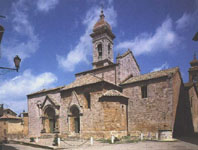 SAN QUIRICO D'ORCIA Originally an Etruscan town, it acquired importance thanks to the neighbouring Via Franchigena. Federico Barbarossa, in 1154, received the ambassador of Pope Adrian IV here and this event is recalled in the "Festa del Barbarossa", 3� Sunday of June. In 1167 it was seat of the Imperial Vicar. The Florence of Cosimo I de' Medici purchased it in 1559. The Collegiata of SS. Quirico and Giuditta is in the Romanesque style: it has three portals and one whit faces southern is attributed to Giovanni Pisano. Inside is found the polyptych of Sano di Pietro and a Chorus from 1432-1502. Palazzo Chigi is from the XVII century. The "Horti Leonini"(16 th century) are one of the first examplesof of Italia Garden style: from August to October there is an exhibition of sculpture "Forms in green". The Romanesque parish church of S. Maria Assunta was, perhaps, constructed on the remains of a pre- Cristian temple. The inside of the church of S. Francesco holds two wooden polychrome statues and a Robbia's Madonna. The area of Bagno Vignoni was known about from roman times through the benefits of the waters from its spring which gush forth at temperatures of more 50�C. and are gathered in the big basin which lies at the centre of the town and gives it its evocative appearance. There is a small sanctuary dedicated to S. Caterina from Siena situated at the side of the basin. The castle of Vignoni looks down upon the town and can be roached either by S. Quirico or by Bagno Vignoni: a natural walk which can be made on foot.
SAN QUIRICO D'ORCIA Originally an Etruscan town, it acquired importance thanks to the neighbouring Via Franchigena. Federico Barbarossa, in 1154, received the ambassador of Pope Adrian IV here and this event is recalled in the "Festa del Barbarossa", 3� Sunday of June. In 1167 it was seat of the Imperial Vicar. The Florence of Cosimo I de' Medici purchased it in 1559. The Collegiata of SS. Quirico and Giuditta is in the Romanesque style: it has three portals and one whit faces southern is attributed to Giovanni Pisano. Inside is found the polyptych of Sano di Pietro and a Chorus from 1432-1502. Palazzo Chigi is from the XVII century. The "Horti Leonini"(16 th century) are one of the first examplesof of Italia Garden style: from August to October there is an exhibition of sculpture "Forms in green". The Romanesque parish church of S. Maria Assunta was, perhaps, constructed on the remains of a pre- Cristian temple. The inside of the church of S. Francesco holds two wooden polychrome statues and a Robbia's Madonna. The area of Bagno Vignoni was known about from roman times through the benefits of the waters from its spring which gush forth at temperatures of more 50�C. and are gathered in the big basin which lies at the centre of the town and gives it its evocative appearance. There is a small sanctuary dedicated to S. Caterina from Siena situated at the side of the basin. The castle of Vignoni looks down upon the town and can be roached either by S. Quirico or by Bagno Vignoni: a natural walk which can be made on foot.
TOP
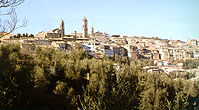 MONTALCINO Without doubt, Montalcino lives a life of many souls. Montalcino as the birthplace of Brunello wine, whic someone once defined as the best and most renowned wine in Italy. From the height of its 564 m. the ancient town dominates the surrounding countryside, clinging to the slopes of a hill crowned by the imposing 14th-century fortress. In the labyrinth of little streets, amongst artisans'shops, small caf�s and places selling typical local produce ( besides the wine, their honey and locally-made biscuits called "dead bones" are also well-known) the sights worth seeing are the fine Town Hall, the Bishp's Palace ( housing the United Civic, Diocesan and Archaeological Museums, with works by important 13th-16th century Sienese artists, such as Bartolo di Fredi, Il Sodoma, Bartolomeo Neroni), the antique Crucifix of Saint Antimus dating back to the mid-12th century, and the churches of Saint Augustine, Saint Giles and Saint Francis, all built between the 13th and 14th centuries, as well as the Sanctuary of our Lady of Succour. But it is just a little way out of town, near Castelnuovo dell'Abate in the Starcia valley that thhe heart of Montalcino spirituality is to be found:the Romanesque abbey of St.Antimus, a striking little temple enveloped in an almost magical atmosphere, founded by Charlemagne in 781. Finally, there are several castles on Montalcino land: the one worthy of mention is Poggio alle Mura, which has Longobard origins.
MONTALCINO Without doubt, Montalcino lives a life of many souls. Montalcino as the birthplace of Brunello wine, whic someone once defined as the best and most renowned wine in Italy. From the height of its 564 m. the ancient town dominates the surrounding countryside, clinging to the slopes of a hill crowned by the imposing 14th-century fortress. In the labyrinth of little streets, amongst artisans'shops, small caf�s and places selling typical local produce ( besides the wine, their honey and locally-made biscuits called "dead bones" are also well-known) the sights worth seeing are the fine Town Hall, the Bishp's Palace ( housing the United Civic, Diocesan and Archaeological Museums, with works by important 13th-16th century Sienese artists, such as Bartolo di Fredi, Il Sodoma, Bartolomeo Neroni), the antique Crucifix of Saint Antimus dating back to the mid-12th century, and the churches of Saint Augustine, Saint Giles and Saint Francis, all built between the 13th and 14th centuries, as well as the Sanctuary of our Lady of Succour. But it is just a little way out of town, near Castelnuovo dell'Abate in the Starcia valley that thhe heart of Montalcino spirituality is to be found:the Romanesque abbey of St.Antimus, a striking little temple enveloped in an almost magical atmosphere, founded by Charlemagne in 781. Finally, there are several castles on Montalcino land: the one worthy of mention is Poggio alle Mura, which has Longobard origins. TOP
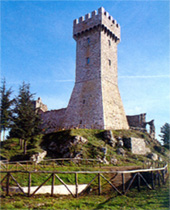 RADICOFANIThe town dominates the Val d'Orcia from a top an isolated rock, from which rise the ruins of an ancient castle. It was an important location along the border of the Roman state. The fortifications which Cosimo I ordered on account of the explosion of a powder magazine in 1735 have since been destroyed. Radicofani remains famous for the deeds of the bandit Ghino di Tacco who lived here for many years. Works in terracotta by Luca della Robbia are kept within the church of S. Pietro. The church of S. Agata in the gothic-Sienese style. The evocative Edificio della Posta from l6th century with its facade and double "loggia" is found on Via Francigena. Many illustrious men have stayed here, among them Chateaubriand, Dickens and Montaigne, this last being particularyly passionate about the Italian cousin and appreciative of the use of olive oil in the preparation of certain dishes. In his writing recalled the cordiality and hospitality of the Tuscans.
RADICOFANIThe town dominates the Val d'Orcia from a top an isolated rock, from which rise the ruins of an ancient castle. It was an important location along the border of the Roman state. The fortifications which Cosimo I ordered on account of the explosion of a powder magazine in 1735 have since been destroyed. Radicofani remains famous for the deeds of the bandit Ghino di Tacco who lived here for many years. Works in terracotta by Luca della Robbia are kept within the church of S. Pietro. The church of S. Agata in the gothic-Sienese style. The evocative Edificio della Posta from l6th century with its facade and double "loggia" is found on Via Francigena. Many illustrious men have stayed here, among them Chateaubriand, Dickens and Montaigne, this last being particularyly passionate about the Italian cousin and appreciative of the use of olive oil in the preparation of certain dishes. In his writing recalled the cordiality and hospitality of the Tuscans. TOP
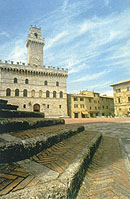 MONTEPULCIANOThis is the largest Comune in the Sienese Valdichiana and contains six other villages: Abbadia di Montepulciano, Acquaviva, Gracciano, Montepulciano Stazione, S.Albino and Valiano. The poet Agnolo Ambrogini (known as "il Poliziano" from the Latin "mons Politianus") was born here. The town is said to have been founded by the Etruscan king Porsenna and exhibits impressive architecture, mainly but not only Renaissance. Michelozzo, Baldassarre Peruzzi and Vignola all worked here, as did Antonio da Sangallo il Vecchio who designed the temple of San Biagio. Apart from the wonders of the historical centre of Montepulciano the tourist would do well to visit the spa centre at S.Albino. The local economy is based on agriculture and the town is famous for its Vino Nobile. In th summer the town hosts the "Cantiere Internazionale d'arte" and in the mid-Augut holidays the "Bruscello", a traditional show spoken in rhyme, is performed on the Cathedral steps. On August 29 a wine barrel race, the "Bravio", is run between the different contrade, or districts, of the town and there is a procession in 13th-century dress.
MONTEPULCIANOThis is the largest Comune in the Sienese Valdichiana and contains six other villages: Abbadia di Montepulciano, Acquaviva, Gracciano, Montepulciano Stazione, S.Albino and Valiano. The poet Agnolo Ambrogini (known as "il Poliziano" from the Latin "mons Politianus") was born here. The town is said to have been founded by the Etruscan king Porsenna and exhibits impressive architecture, mainly but not only Renaissance. Michelozzo, Baldassarre Peruzzi and Vignola all worked here, as did Antonio da Sangallo il Vecchio who designed the temple of San Biagio. Apart from the wonders of the historical centre of Montepulciano the tourist would do well to visit the spa centre at S.Albino. The local economy is based on agriculture and the town is famous for its Vino Nobile. In th summer the town hosts the "Cantiere Internazionale d'arte" and in the mid-Augut holidays the "Bruscello", a traditional show spoken in rhyme, is performed on the Cathedral steps. On August 29 a wine barrel race, the "Bravio", is run between the different contrade, or districts, of the town and there is a procession in 13th-century dress.
TOP
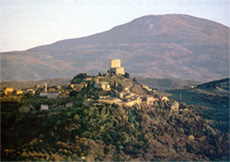 CASTIGLION D'ORCIA The territory of the commune of Castiglione is situated in the middle of the valley of the river Orcia and therefore in the Artistical, Natural and Cultural Park of Orcia valley.
Here the natural environment has remained, on the whole, unchanged, and both the agriculture and the woodlands are carefully tended to.Grape vines and olive groves cover the hillsides around Castiglione producing wine and above all, an excellent olive oil.
The villages within this commune all have their own individual cheracteristics and are rich in history and culture. Castiglion d'Orcia is a pretty village which is said to be the birthplace of the 15th century artist Lorenzo di Pietro or �il Vecchietta�, and there is a beautiful well which bears his name. Also worth a visit is the Romanesque Church of S. Maria and the Parrocchiale, where important works by Pietro Lorenzetti, Simone Martini, Giovanni di Paolo, Segna di Bonaventura, il Vecchietta and other artists of his school.
Rocca d'Orcia is a delightful medieval Hamlet, on the outskirts of Castiglione, which is dominated by the imposing Rocca a Tentennano, where Saint Caterina of Siena stayed.
Bagni San Filippo is a thermal resort with sulphurous waters which are considered amongst the best in Europe are used in mud, inhalation and irrigation treatments.
Other fraction of the commune is Campiglia d'orcia, positioned below a tall bell tower built on a rocky spur. The medieval castle, belonged to the Visconty family, merits careful restoration for its panoramic position alone.
CASTIGLION D'ORCIA The territory of the commune of Castiglione is situated in the middle of the valley of the river Orcia and therefore in the Artistical, Natural and Cultural Park of Orcia valley.
Here the natural environment has remained, on the whole, unchanged, and both the agriculture and the woodlands are carefully tended to.Grape vines and olive groves cover the hillsides around Castiglione producing wine and above all, an excellent olive oil.
The villages within this commune all have their own individual cheracteristics and are rich in history and culture. Castiglion d'Orcia is a pretty village which is said to be the birthplace of the 15th century artist Lorenzo di Pietro or �il Vecchietta�, and there is a beautiful well which bears his name. Also worth a visit is the Romanesque Church of S. Maria and the Parrocchiale, where important works by Pietro Lorenzetti, Simone Martini, Giovanni di Paolo, Segna di Bonaventura, il Vecchietta and other artists of his school.
Rocca d'Orcia is a delightful medieval Hamlet, on the outskirts of Castiglione, which is dominated by the imposing Rocca a Tentennano, where Saint Caterina of Siena stayed.
Bagni San Filippo is a thermal resort with sulphurous waters which are considered amongst the best in Europe are used in mud, inhalation and irrigation treatments.
Other fraction of the commune is Campiglia d'orcia, positioned below a tall bell tower built on a rocky spur. The medieval castle, belonged to the Visconty family, merits careful restoration for its panoramic position alone.TOP

